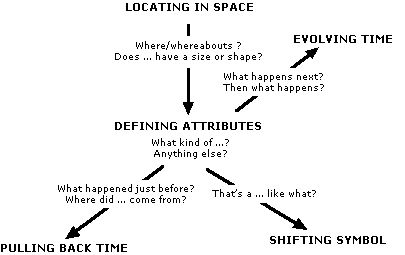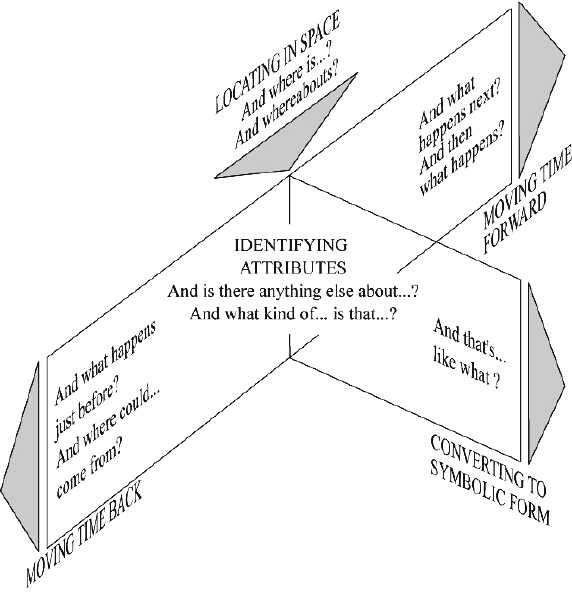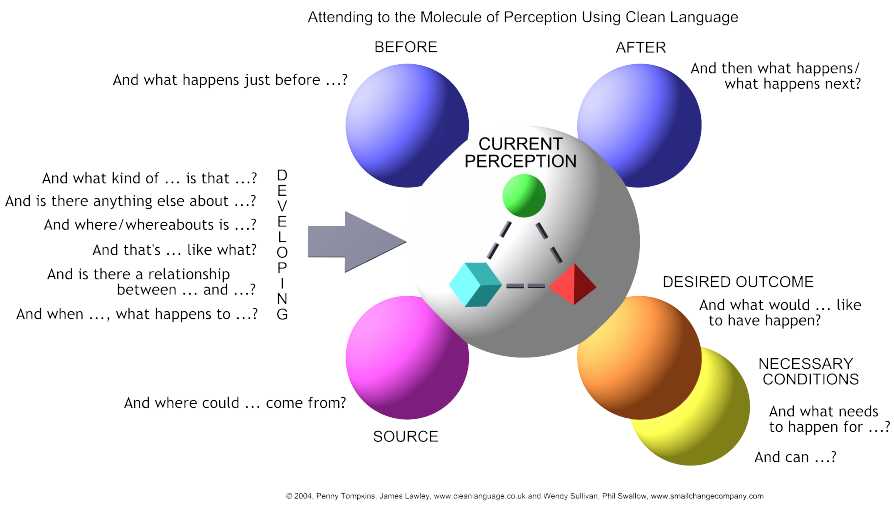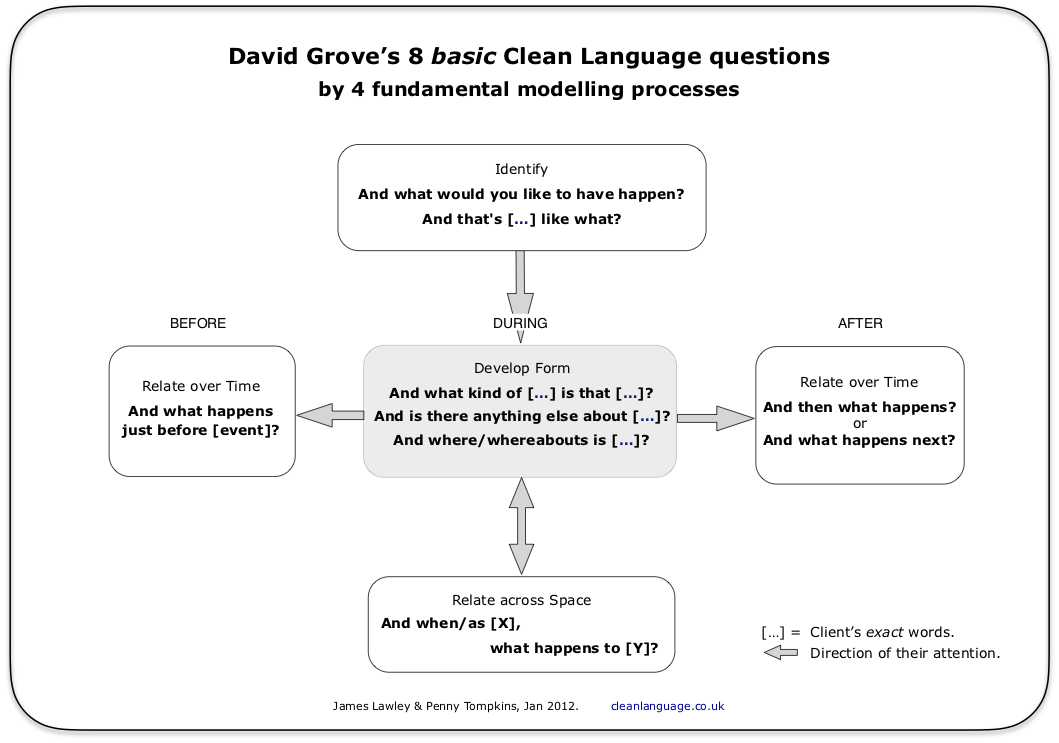First published in Rapport, Autumn 2004
“Clean Language facilitates the client’s process, ensuring that the client’s meaning and resonance remain wholly in tact, uncontaminated by the therapist’s words. It opens the door to change.” David Grove 1We published our first article on David Grove’s Clean Language, Less is More, in 1997.2 Since then our model of Clean Language has undergone two revisions. Below we document these changes and explain why they happened. By charting the development of our thinking we demonstrate how modelling over the long-term is an evolutionary process.
Where did Clean Language come from?
David Grove originated Clean Language in early 1980’s. He noticed that his psychotherapy clients often used metaphors to describe their most traumatic or difficult experiences. He also discovered that if he asked ordinary questions about these metaphors they had a “short half-life”, i.e. they quickly disappeared and the client reverted to their usual conceptual description. Through experimentation he found that if he asked very simple questions that made maximal use of the clients exact words and minimally presupposed any other information, client’s metaphors would stay around long enough to “confess their strengths”. And when they did, clients reported that their symptoms started to heal in unexpected ways. As a result David embarked on a 20-year journey into the world of metaphor and the use of Clean Language.
David Grove’s questions are ‘clean’ because they minimally ‘contaminate’ the client’s perceptions with the therapist or coach’s own m.a.p. (metaphors, assumptions and presuppositions). The facilitator is only allowed to use the client’s words and the precise wording of the questions. Facilitators do not add any words of their own. David Grove says “The I-ness of the therapist should appear to cease to exist” (Resolving Traumatic Memories, p.22) Instead, the aim of a clean question is to invite the client to attend to a particular aspect of their own experience. In the context of therapy or coaching, ‘clean’ does not mean ‘no influence’. Quite the contrary, these questions are highly influential because they are clean. This is a very different kind of influence to that of most other questions.
Symbolic Modelling
David Grove is the originator of Clean Language. Our contribution has been to specify the components of Clean Language: the syntax, vocal qualities, nonverbals, and clean questions. We have also categorised and explained the value of the questions, extended their function outside of psychotherapy, and situated them within a modelling frame – called Symbolic Modelling.
Symbolic Modelling is a bottom-up systemic process. It utilises Clean Language, client-generated metaphor and modelling. Modelling is the methodology, metaphor the medium, and Clean Language is the means.
Modelling David Grove
We will be eternally grateful to David Grove for consistently grounding his research in the experience of his clients. By the time we started modelling David in 1995 he had developed a tried-and-tested (but ever changing) set of clean questions. Every year since then we have attended his retreats and workshops in the UK (and a few in the USA). This has enabled us to observe him working with a wide range of individuals and to experience the process for ourselves as clients.
One of our outcomes was to produce a model which covered the entire history of David’s use of Clean Language and was not related to the order in which he discovered the questions. We taped every client session we could and spent hours examining the transcripts for patterns. We also obtained tapes, videos and transcripts of him working between 1989 to 1992 so we had access to his early use of Clean Language.
One of our modelling techniques was to take sample client sessions from across the years and count the number of times he asked each question. We discovered that he used variations of the same nine questions over and over. These accounted for as much as 80% of all questions he asked.
A breakthrough in our thinking came when we started to classify the questions by the kind of experience they invited the client to attend to. This led us to realise that Clean Language was ideal for modelling “the structure of subjective experience” in general, and metaphoric perception and symbolic representations in particular.
Version 1 (1996)
Because the totality of a client’s symbolic representations is called a Metaphor Landscape, we adopted the metaphor of a compass to show how the questions facilitated the client to navigate around their own landscape (see Figure 1). The arrows of the compass indicate the ‘direction’ the client’s attention moves in order to access one of five classes of information:
- The attributes of a symbol or a component of perception
- The location of a symbol within perceptual space
- A subsequent event (after)
- A previous event (before)
- A shift/conversion/translation from conceptual or abstract description to an equivalent metaphor or symbolic representation.
The ‘nine-question compass’ model was first published in the Spring 1997 issue of Rapport:

Figure 1: The original nine-questions compass (Note: “…” are the client’s exact words)
The basic nine clean questions are context independent and can be asked almost anytime during the process. In addition to the basic questions we identified a further 20 or so specialised questions which David Grove asked occasionally, but only under certain conditions. The specialised questions are only clean when the client has stated or presupposed a relevant context exists in their Landscape. For example, a client says:
They’re coming at me all at once.Because the client’s language presupposes there is more than one of ‘them’, the specialised question “And how many …?” can legitimately be asked:
And how many could be coming at you all at once?(Note: Words in bold have been introduced by the facilitator.)
Version 2 (1998)
By 1998 we had made two modifications to our first model. We shifted “And does … have a size or shape?” from the basic to the specialised category. We also separated “And where is …?” and “And whereabouts …?” into individual questions. These changes resulted from two insights.
First, “And does … have a size or shape?” is only clean when the client has referred to part of their experience as an ‘it’ or presupposed that it is thing-like. Perceiving our experience as thing-like is very common — but it is not universal. For instance, in the metaphor “I need to let go of my anger,” anger is referred to as if it is something that can be “let go of”. Therefore it is clean to ask the ‘Size or shape?’ question:
And when you need to let go of your anger, does that anger have a size or a shape?
Whereas “I need to feel angry” characterises anger as a sensation which may or may not be thing-like. Therefore it would not be clean to ask the ‘Size or shape?’ question. This question requires that certain conditions exist before it can be asked cleanly, so we moved it to the list of specialised questions.
Second, in English ‘Whereabouts?’ can either mean ‘where approximately?’ (e.g. “And whereabouts is your future?”) or ‘where more specifically?’ (e.g. “And whereabouts inside?”). The difference depends on whether ‘Whereabouts?’ is asked of a symbol or of an already specified location. To fill the gap left by the removal of ‘Size or shape?’ from the compass we split ‘Where?’ and ‘Whereabouts?’ into individual questions.
Figure 2 shows the version of the compass which appeared in our book Metaphors in Mind: Transformation through Symbolic Modelling published in 2000.3

Figure 2: The updated 9-basic clean question compass
Version 3 (2003)
Since Metaphors in Mind was published we have trained hundreds of people to use Clean Language and have observed how they have acquired the model. We have also observed how students who became expert at asking the questions apply the model. In addition, discussions with other trainers of Clean Language and Symbolic Modelling stimulated our thinking. As a result we have updated the model again and it has acquired a greater independence from its source, David Grove – with his blessing we might add.
The criteria by which a question was included in the original model was frequency of use by David Grove. In the latest version our criteria has moved away from David’s use of Clean Language (he is currently developing Clean Space 4) and towards people acquiring an inclusive set of questions which can be used in a variety of applications; naturally in psychotherapy and coaching, but also in health, business and education.
We call the latest version the ‘9+3 Basic Clean Language Questions’. It is possible to conduct entire Symbolic Modelling sessions with just these twelve. We have continued to classify the questions by what they invite the client to attend to. Each category is based on a fundamental metaphor of perception that almost everyone uses to construct their model of the world and organise their experience:
| DEVELOPING (THE CURRENT PERCEPTION): | |
| ATTRIBUTES | And is there anything else about … ? |
| And what kind of … ? | |
| LOCATION | And where/whereabouts is … ? |
| RELATIONSHIP | And is there a relationship between … and … ? |
| And when …, what happens to … ? | |
| METAPHOR | And that’s … like what? |
| MOVING TIME: | |
| BEFORE | And what happens just before … ? |
| AFTER | And then what happens/what happens next? |
| SOURCE | And where does/could … come from? |
| INTENTION: | |
| DESIRED OUTCOME | And what would … like to have happen? |
| NECESSARY CONDITIONS | And what needs to happen for … ? |
| And can … ? | |
From Compass to Molecule
Figure 3 uses a molecule to depict the client’s experience. We switched from a compass to a molecule metaphor for two reasons. First we want to emphasise interconnectedness rather than direction. Second, the molecule represents the client’s perception, both foreground (inside the centre sphere) and background (outside the centre sphere). As modellers we want the client’s perceptions to be central to everything the facilitator says and does. By placing the questions around the outside we are emphasising that first the facilitator decides which sphere of perception they would like the client to attend to, and then they ask a question that invites them to attend to that part of their experience.

Figure 3: Attending to the ‘molecule’ of perception using the 9+3 basic Clean Language questions (The arrow signifies that the ‘developing questions’ are asked of the current perception)
Our Thinking Changes
Developing questions hold time still and maintain the client’s attention on some aspect of their current perception. Version 3 includes two extra developing questions which invite the client to attend to the relationship between two aspects (‘X’ and ‘Y’) of their Metaphor Landscape:
And is there a relationship between ‘X’ and ‘Y’ ? And when ‘X’, what happens to ‘Y’ ?
We consider these two questions basic because human perception is a gestalt; it is interconnected and therefore symbols in a Metaphor Landscape are always in relation to each other. In fact every sentence contains words which indicate relationships – verbs and prepositions for instance.
The second major change is the inclusion of a new category of intention questions. The distinction between the first nine basic questions and the ‘+3’ intention questions is vital. The first nine are used to model ‘what is’. The three intention questions invite the client to self-model their desired outcome and the conditions under which that outcome can happen. The intention questions, coupled with the client’s desire to change, turn Symbolic Modelling from a ‘pure’ modelling process into a modelling-based change process. This is why “And what would you like to have happen?” is used to initiate most Symbolic Modelling therapy or coaching sessions.
Other minor revisions to the model involved deciding that ‘Where?’ and ‘Whereabouts?’ invite the client to attend to the same kind of experience (i.e. the location of an item in their perceptual space) and could therefore be regarded as variations of the same question. You may have noticed that this reverts to the formulation in version 1 of the model!
We also decided that both ‘Then what happens?’ and ‘What happens next?’ invite a client to attend to an event after the one currently in their perception. In common parlance, ‘forward in time’. Therefore we now classify these two questions as one.
The final change in version 3 is the separation of “And where could/does … come from?” into its own category called Source. We did this to make it clear that this question invites the client to attend to a different kind of information (the origin of ‘X’, cause of ‘X’ or from whence ‘X’ came) than simply ‘Moving Time Back’ to the previous event.
Example
Using Figure 3 as a guide we take a client’s statement and show how each of the 9+3 questions invites them to attend to a different sphere of their experience.
Facilitator: And what would you like to have happen? Client: I would like to feel strong and stand up to others.
At this point, as a facilitator you have numerous options depending on where you wish to direct the client’s attention. Below we list these options in two broad categories:
- Within the client’s current perception (inside the centre sphere of Figure 3).
- Outside the current perception (to one of the surrounding spheres).
The left-hand column indicates the sphere of experience you want the client to attend to, the right-hand column the clean question that will likely direct the client’s attention there.
| WITHIN THE CURRENT PERCEPTION | |
| ATTRIBUTES | And is there anything else about stand up to others? |
| And what kind of strong is that strong? | |
| LOCATION | And where/whereabouts do you feel strong? |
| RELATIONSHIP | And is there a relationship between feel strong and stand up to others ? |
| And when you feel strong, what happens to others? | |
| METAPHOR | And that’s strong like what? |
| OUTSIDE THE CURRENT PERCEPTION | |
| EVENT BEFORE | And what happens just before you feel strong? |
| EVENT AFTER | And then what happens/what happens next? |
| SOURCE | And where does/could that feel strong come from? |
| DESIRED OUTCOME | And when you’d like to feel strong and stand up to others, what would you like to have happen now? |
| NECESSARY CONDITIONS | And what needs to happen for you to feel strong? |
| And can you feel strong? | |
Working Systemically
Within Symbolic Modelling, Clean Language is applied systemically. That is with an awareness of working with the non-linear and emergent properties of a human system. Clean Language can be used in this way because:
- The simplicity of the questions enable a system’s complexity to emerge ‘uncontaminated’ by the metaphors, assumptions and presuppositions of the facilitator.
- It works with a system’s natural tendency to display an idiosyncratic directionality, i.e. to follow a unique developmental path.
- It can work at multiple levels of organisation: component, relationship, pattern, and pattern of organisation.
- By enabling an individual or group to map a network of relationships they discover the wisdom in their own system that is not contained in any of the parts, but is embodied in the configuration of the whole.
When using Symbolic Modelling in a therapy or coaching context, the facilitator’s role is to use Clean Language to invite the client to attend to various aspects of their perception so that they self-model. The client’s role is to find out how their perceptions work together as a system – and for that to operate as feedback so that they continually learn from their own experience.
And because we keep learning from our colleagues, students and clients, we can be sure that in the years to come our model of Clean Language with evolve still further.
© 2004, James Lawley and Penny Tompkins
POSTSCRIPT
- A later, simplified set of ‘basic’ questions can be found in the chapter Symbolic Modelling: Emergent Change though Metaphor and Clean Language (2011). It contains only 8 questions:

References
1 David J. Grove and B.I. Panzer, Resolving Traumatic Memories: Metaphors and Symbols in Psychotherapy, Irvington, 1989, p. 1.
2 Penny Tompkins and James Lawley, Less is More … The Art of Clean Language, Rapport, Issue 35, February 1997.
3 James Lawley and Penny Tompkins, Metaphors in Mind: Transformation through Symbolic Modelling, The Developing Company Press, 2000.
4 Penny Tompkins and James Lawley, Clean Space: Modeling Human Perception through Emergence, Anchor Point, Vol. 17, No. 8, September 2003.
Thanks to Phil Swallow, Wendy Sullivan and Marian Way for feedback and helpful suggestions.
Postscript August 2023
We have undertaken a major review of ‘specialised’ or ‘contextually’ clean questions at:
Context makes Clean clean







